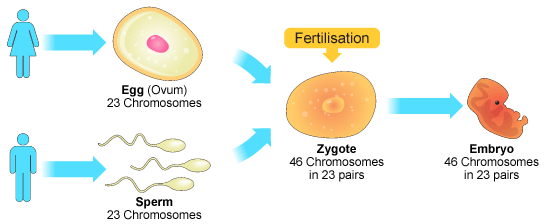Reproduction Definition
“Reproduction is the process of producing offsprings that are biologically or genetically similar to the parent organism.”
What is Reproduction?
Reproduction means to reproduce. It is a biological process by which an organism reproduces an offspring who is biologically similar to the organism. Reproduction enables and ensures the continuity of species, generation after generation. It is the main feature of life on earth.
Let us have a detailed overview of reproduction, its types and the modes of reproduction in plants and animals.
Types of Reproduction
There are basically two types of reproduction:
- Asexual Reproduction
- Sexual Reproduction
Asexual Reproduction
“Asexual reproduction refers to the type of reproduction in which only a single organism gives rise to a new individual.”

Asexual reproduction does not involve the fusion of gametes, and therefore, the offsprings produced are genetically identical to the parent. The organisms produced by asexual reproduction are less diverse in nature. This type of reproduction is practised widely by unicellular organisms.
The process involves rapid population growth and no mate is required for the process. However, lack of genetic diversity makes the organisms more susceptible to diseases and nutrition deficiencies.
Asexual reproduction is further divided into:
- Binary Fission: In this, the cell splits into two each cell carrying a copy of the DNA from the parent cell. For eg., amoeba.
- Budding: In this, a small bud-like outgrowth gives rise to a new individual. The outgrowth remains attached to the organism until it is fully grown. It detaches itself as lives as an individual organism. For eg., hydra
- Fragmentation: In this, the parent organism splits into several parts and each part grows into a new individual. For eg., Planaria
- Sporogenesis: In this type of reproduction, a new organism grows from the spores. These can be created without fertilization and can spread through wind and animals
Sexual Reproduction
“Sexual reproduction is a type of reproduction that involves the production of an offspring by the fusion of male and female gametes.”

In sexual reproduction, male and female gametes form to produce an offspring. These gametes are either formed by the same individual or by different individuals of the opposite sex.
This process is usually slow and complex compared to asexual reproduction. The organisms so produced are genetically diverse. Thus, they can evolve along with the changing climatic conditions. Humans and many multicellular organisms exhibit a sexual mode of reproduction.
Reproduction in Plants
Plants reproduce by sexual and asexual means. Vegetative reproduction is the main mode of plant reproduction. Roots such as corm, stem tuber, rhizomes and stolon undergo vegetative propagation.

Sexual reproduction in plants takes place through pollination in which the pollen grains from the anther of a male flower transfer to the stigma of the female flower.
Few plants produce seeds without fertilization and the process is called apomixis. Here, the ovule or the ovary gives rise to new seeds.
Reproduction in Animals
Animals reproduce sexually as well as asexually. Sexual reproduction involves the fusion of male and female gametes. This process is known as fertilization. Fertilization can be external or internal. External fertilization is the process in which the male sperm fertilizes the female egg outside the female’s body. On the contrary, in internal fertilization, the fusion of male and female gametes takes place inside the body of the female.
Asexual reproduction involves reproduction processes such as binary fission, budding, fragmentation, etc. The organisms have no reproductive systems and therefore no formation of male and female gametes takes place.
Thus we see how beneficial reproduction is to continue life on earth.
No comments:
Post a Comment